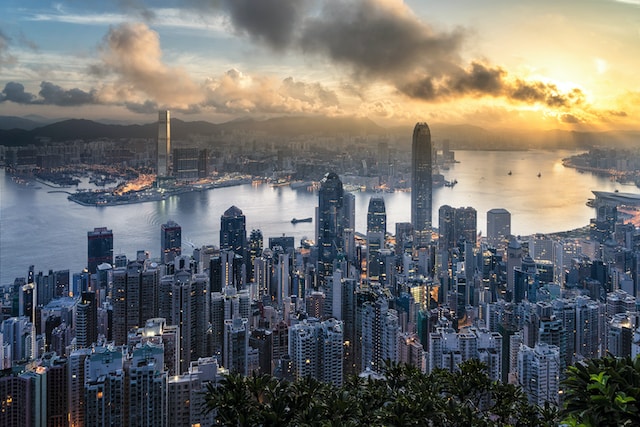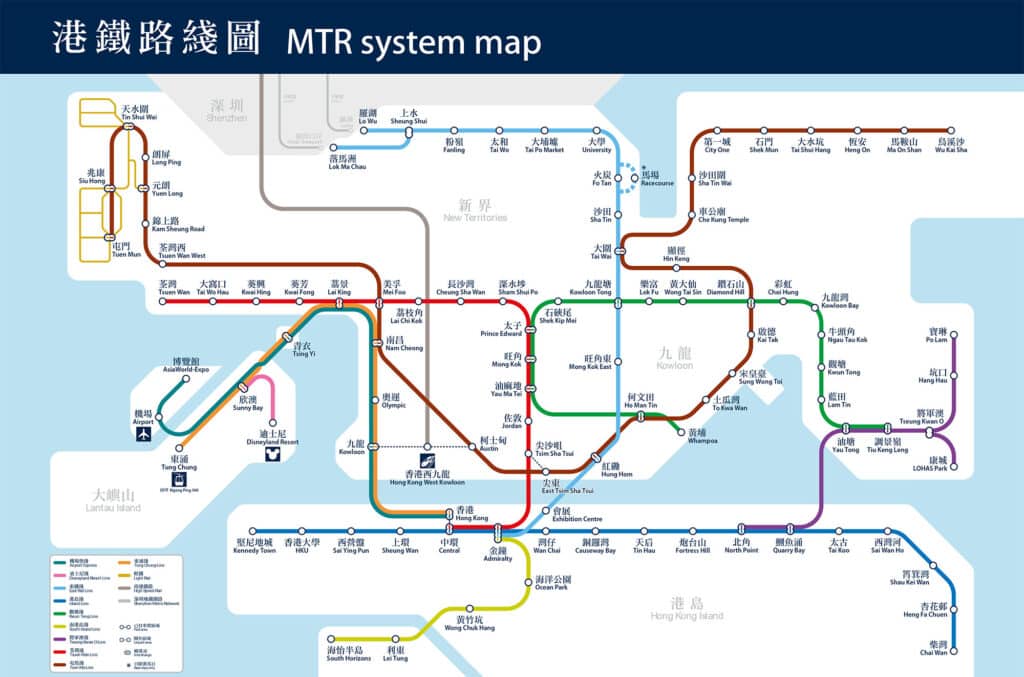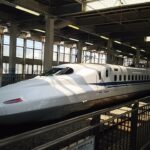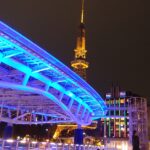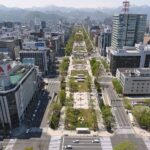Hong Kong has an extensive public transportation system that works well and is easy for both locals and tourists to use. Hong Kong’s public transportation system includes buses, taxis, trams, ferries, and the MTR. Buses are the most popular form of public transportation, and they go to most places in the city. The MTR, on the other hand, is the fastest and most efficient way to get around. Minibuses with set lines can take you to more remote places, and ferries can help you get from Hong Kong Island to Kowloon. The Hong Kong Tramway is also a great way to take your time and see the city.
Mass Transit Railway (MTR): basic information
The subway, or metro, system in Hong Kong is a kind of public transit that is of world-class standard and connects the entire city. The Mass Transit Railway (MTR), which is in charge of running this system, provides commuters with service that is quick, efficient, and dependable. There are three airport express lines, one tourist line, and one light rail line in addition to the nine metropolitan lines that make up the network. It encompasses a vast network of more than 200 stations, giving travelers convenient access to the city’s most important locations and points of interest. A wide range of convenient services, such as stored value cards, mobile ticketing, and integrated transit planning, are provided by the MTR. Because the system is connected to numerous of the region’s most important cities, using it as a means of transportation within the Pearl River Delta region is both easy and effective.
The lines of the Hong Kong subway system
The Mass Transit Railway (MTR) is comprised of nine different metro lines, all of which are interconnected with one another to make it simple for commuters to switch from one line to another. Kwun Tong Line, Tsuen Wan Line, Island Line, Tung Chung Line, Airport Express, East Rail Line, West Rail Line, Ma On Shan Line, and South Island Line are the nine lines that make up the system. Commuters have an easier time getting to their destinations in a timely and comfortable manner thanks to the fact that each of these lines serves a distinct region of the city.
The Kwun Tong Line is the oldest and busiest of the nine lines, and it runs from Kwun Tong in Kowloon to Tiu Keng Leng in the New Territories. It provides access to a variety of well-known locations, some of which include Mong Kok, Kowloon Tong, Sha Tin, and Fanling. The Hong Kong Science Museum, the Hong Kong Heritage Museum, and the Hong Kong Museum of Coastal Defense are some of the destinations that can be reached through the Tsuen Wan Line, which travels from the western portion of Kowloon to Tsuen Wan in the New Territories.
The Kennedy Town station on the western side of Hong Kong Island is connected to the Chai Wan station on the island’s eastern side by the Island Line. The Hong Kong Convention and Exhibition Centre, Ocean Park Hong Kong, and the Victoria Peak Tram are just a few of the destinations that can be reached using this station. The Tung Chung Line begins its journey at Tung Chung on Lantau Island and terminates at Hong Kong Station in Central. Along the way, it provides service to a variety of popular destinations, such as Hong Kong Disneyland and the Hong Kong International Airport.
The Airport Express, a non-stop express service that departs from Hong Kong Station in Central and travels to the airport, is a way to get to the Hong Kong International Airport. Because it takes only 24 minutes to get from one end of the route to the other, it is a fast and easy way to get to and from the airport. The Hung Hom Station in Kowloon is the starting point for the East Rail Line, which travels all the way to the Chinese border at Lo Wu. Along the route, it provides service to a variety of cities, some of which are Sha Tin, Tai Po, and Fanling.
The Hung Hom Station in Kowloon is the starting point for the West Rail Line, which travels all the way to Tuen Mun in the New Territories. It provides access to a variety of tourist destinations, such as the Hong Kong Wetland Park, the Mai Po Nature Reserve, and the Ten Thousand Buddhas Monastery. The Tai Wai Station in Sha Tin is the starting point for the Ma On Shan Line, which travels all the way to Wu Kai Sha in Ma On Shan. It provides access to a number of popular destinations, such as the Shatin Racecourse and the MTR Tai Wai Station.
Lastly, the South Island Line travels from Admiralty Station in Central to South Horizons Station in the Southern District of Hong Kong Island. This route was recently completed. This line provides service to a number of well-known tourist destinations, such as the Aberdeen Promenade, Cyberport, and Ocean Park Hong Kong.
The Mass Transit Railway (MTR) is widely regarded as one of the most user-friendly and dependable means of transportation in Hong Kong. The nine different metro lines are well maintained, run smoothly, and offer convenient access to a large number of the city’s most visited attractions. Because of its large network, the MTR makes traveling throughout Hong Kong simple and inexpensive.
Map of Hong Kong Metro 2023 – Free Download in PDF
The Metro 2023 map of Hong Kong is now available for free download in PDF format. With this map, users can easily navigate the streets, parks, and transportation systems in the city. This is a great tool for anyone looking to explore the city and make the most of their trip to Hong Kong.
Public transport tickets in Hong Kong – Best types for travelers & actual prices
Getting around the city on Hong Kong’s public transit is a quick and easy way to get around at a price that won’t break the bank. There are a plethora of transportation alternatives available thanks to the huge network of buses, minibuses, subways, and trams. There is a selection of tickets available to choose from, and your selection should be based on your requirements.
The Octopus Card is by far the most widely used option for purchasing tickets. It is a contactless smart card that may be used for travel on all forms of public transit and for purchases made at convenience stores as well as grocery stores. It is available for purchase in any denomination up to 500 HKD, and more value can be added at any MTR station or 7-Eleven store in Hong Kong. The card has a total cost of 150 HKD, which is broken down as follows: a refundable deposit of 50 HKD and a stored value of 100 HKD.
A ticket can be purchased for a single journey at any MTR station or directly from the bus driver at any of those stations. The price of a ticket ranges from $2.30 to $4.00 for a single journey on the bus, with the price depending on the distance traveled.
You have the option of purchasing either a One-Day Pass or a Tourist Day Pass if you plan on using the system more than once. The One-Day Pass costs 35 HKD and allows the holder to take an unlimited number of journeys on the MTR as well as franchised buses and minibusses for a single day. The Tourist Day Pass costs 55 HKD and allows the holder to take an unlimited number of journeys on the MTR, franchised buses, and minibusses, as well as the Airport Express, for a single day.
You have the option of purchasing an Airport Express Travel Pass for 240 HKD. This pass allows you unlimited travel on the Airport Express as well as the MTR for a period of three days. Tourists coming to Hong Kong for a stay of three days will find this to be an excellent option because it provides a discount on MTR and Airport Express rides as well as permits unlimited use of both services.
Summary of fares for public transport in Hong Kong
- The Octopus Card is a contactless smart card that can be used for travel on all public transportation
- Single-ride tickets can be purchased from MTR stations or from bus drivers and prices depend on the distance traveled.
- Airport Express Travel Pass is available for tourists visiting Hong Kong for 3 days and provides unlimited travel on MTR and Airport Express at a discounted rate.
Timetables & Schedules of Hong Kong Metro system
Every day of the week, between the hours of 6:00 AM and 1:00 AM, the metro operates, and on Friday and Saturday evenings, there are additional services. Trains arrive at stations with an average frequency of two to four minutes and travel at an average speed of 30 kilometers per hour. A network of subterranean and overground lines is included in the metro system, which makes it simple to travel throughout the city.
What Are Other Options For Public Transportation In Hong Kong?
Outside of the confines of the subway system, a wide array of options for public transportation may be found in Hong Kong. Two separate businesses, Kowloon Motor Bus Company, and New World First Bus, are responsible for running the city’s bus system, which is one of the modes of public transit that is utilized by the greatest number of people. In addition, travelers have access to a diverse selection of ferry services, which can be utilized for travel inside the harbor as well as to some of the islands that are located further afield. Taxis, the city’s tram and light rail systems, and the city’s light rail system are all available anywhere in the city.
how does public bus transportation work in Hong Kong?
Kowloon Motor Bus (KMB), Citybus, Long Win, New Lantao Bus, and New World First Bus are some of the bus companies that provide services in Hong Kong. Other businesses that provide bus transportation in the city include Long Win and New World First Bus. Because every firm has its own set of routes that it travels, it is essential to choose which company travels the path that you want to take. Buses in Hong Kong all have air conditioning and are furnished with an electronic display that provides information about the route being taken and the location of the last stop in both English and Chinese. The electronic display will show the distance that has been traveled, and the fare will be determined based on that distance. Cash, Octopus, and credit cards are all acceptable forms of payment here. The Octopus Card payment system is the most common way of making payments in Hong Kong. It is a smart card payment system that can be used on all kinds of public transportation in Hong Kong.
The most commonly used bus lines or bus numbers in Hong Kong are:
- KMB: A21, E21A, N21, N22
- Citybus: A10, A11, N11, N22
- Long Win: E11A, E11B
- New Lantao Bus: A23
- New World First Bus: A12, N12
How do the public TRAINS work IN HONG Kong?
Train travel is by far the most common method of getting around Hong Kong, thanks to the city’s enormous rail network and a multitude of train stations. You can be sure that the trains will transport you anywhere you need to go, regardless of whether you are traveling to and from work or simply touring the city.
The Mass Transit Railway (MTR) and the Kowloon-Canton Railway Corporation (KCRC) are the two primary companies that run the rail lines that makeup Hong Kong’s extensive rail network. The MTR, which has nine different lines connecting Hong Kong Island, Kowloon, and the New Territories, is in charge of running the majority of Hong Kong’s mass transit system. The KCRC is in charge of managing the East Rail Line, which connects the New Territories to mainland China.
There are a number of different train connections that can take you to other cities in the vicinity, which is convenient for tourists who wish to travel further afield than the city itself. For instance, Hong Kong’s Kowloon-Canton Railway connects the city to places like Beijing, Macau, and Shanghai. The East Rail Line also provides a connection to the Chinese towns of Shenzhen and Guangzhou. Additionally, the MTR provides connections to significant cities in the Pearl River Delta region, such as Zhuhai, Zhongshan, and Dongguan.
The public train system in Hong Kong is, on the whole, a mode of transportation that is very user-friendly as well as dependable. It is the ideal method for exploring the lively city as well as the areas that surround it because it provides regular connections to other cities in the region.
How To Get From Hong Kong International Airport (HKG) To The City Center With Public Transport?
If you are going to be visiting Hong Kong and are looking for a quick and simple method that won’t break the bank to get from the Hong Kong International Airport to the heart of the city, then taking public transit is going to be your best bet.
The first thing you need to do is make your way out of the airport on the Airport Express train. The Airport Express train leaves from the Airport Station, which can be found inside the Arrivals Hall of the airport. You will arrive at Hong Kong Central Station, located smack dab in the middle of the city, after a trip that lasts roughly a quarter of an hour. The price of a ticket to ride the Airport Express train is close to one hundred Hong Kong dollars.
After you have arrived at Central Station, you will have the option of taking a bus or the MTR underground. Buses may be accessed from the Exchange Square Bus Terminus, which is situated directly in front of the Central Station. The fee for the bus will cost you between 5 and 20 HKD, and the trip will take about 30 minutes, however, the exact time might vary greatly depending on the traffic. In addition, you may access the MTR subway at Central Station, which is the quickest method to travel to the heart of the city. The price of the ride on the MTR is approximately ten Hong Kong dollars, and the travel time is approximately ten minutes.
how to spend 3 days in Hong Kong?
The city of Hong Kong is a bustling, cosmopolitan place that offers a wealth of interesting and one-of-a-kind experiences. Whether this is your first time in Hong Kong or you’ve been there before, you won’t run out of things to see and do during your time here; there is simply too much to fit into such a short amount of time.
Begin your quest with a unique experience. Take in the breathtaking scenery of the harbor on the Star Ferry by hopping aboard. The city’s skyscrapers put on their most impressive display at night, making this the perfect time to see them. There is also the option of boarding the Ngong Ping 360 cable car, which provides passengers with amazing views over the city as well as Lantau Island.
The following day, investigate the cuisine of the city. Inquire with the locals about the best eateries in the area, and while you’re there, try some great dim sum, noodles, and other Chinese foods. Experience authentic Hong Kong by going to the Temple Street Night Market and eating some of the delicious street food there. For a memorable time spent shopping, you shouldn’t miss out on the opportunities presented by the marketplaces in Mong Kok and Causeway Bay.
Finally, get a taste of the city’s vibrant nightlife. Enjoy a night out at one of the city’s many nightclubs where you can dance the night away, or take a walk down the Avenue of Stars and take in the spectacular views. You can also go out and visit the city’s various bars and pubs, where you can try some of the local alcoholic beverages and enjoy some live music.
You are guaranteed to have an experience that you will never forget if you stay in Hong Kong for three days. It does not matter how you choose to spend your time there. It doesn’t matter if you’re looking for a lively nightlife, unforgettable adventures, or mouthwatering cuisine, Hong Kong has it all. Therefore, make the most of your stay there by going out and seeing the sights and getting a feel for the local culture.
CHECK OUT THIS AMAZING VIDEO TOUR GUIDE ABOUT HONG KONG PUBLIC TRANSPORTATION
What other metro systems are nearby to Hong Kong?
In proximity to Hong Kong, there are several other major metro systems. The Guangzhou Metro in mainland China is the closest substantial system, serving Guangzhou city and the Pearl River Delta. Another nearby metro system is the Shenzhen Metro, which is also located in mainland China and serves the city of Shenzhen. Across the border in Macau, plans for a light rapid transit system are in progress. Additionally, further afield but still in the region are the Taipei Metro in Taiwan and the extensive metro systems of Japanese cities such as Tokyo and Osaka.
Summary of our tour guide for Hong Kong
The metropolis of Hong Kong is bustling with activity and is home to more than 7 million people. It is famously known for its breathtaking skyline as well as its rich cultural diversity. The city places a significant emphasis on its public transportation system, which includes a vast train network, buses, and ferries that connect the various neighborhoods that make up the city. The city’s reputation as one of the most livable cities in the world is due in large part to the fact that its public transportation system is dependable and user-friendly, making it simple to get around.
Top 5 FAQs and answers about Hong Kong public transport?
- Can you tell me about the various modes of public transportation?
- Ferries, buses, trains, and trams are all a part of Hong Kong’s extensive public transportation network. The MTR is the primary rapid transport system in the city and offers convenient access to the majority of the city’s neighborhoods. The trams are another option, and they provide an excellent opportunity to discover the city at a more leisurely pace. Buses, on the other hand, offer convenient access to a number of locations that are inaccessible via the MTR. Last but not least, there are the ferries, which are a fantastic mode of transportation for discovering the secluded islands and rural regions.
- How much do tickets cost?
- The prices charged for rides on Hong Kong’s public transportation system are not too expensive. It costs between $4.50 and $11 for a single ride on the MTR, with the price varying according to the distance traveled. A single ride on a bus will cost you anywhere from $2.50 to $6.50, whereas a ride on the tram or ferry will just set you back $2.50.
- What kinds of payment methods are available?
- In Hong Kong, the Octopus card is the most widely used form of payment for the city’s public transportation system. It is a prepaid card that may be used to pay for rides on public transportation, including the MTR as well as buses, trams, and ferries. Additionally, it is accepted at a wide variety of shops and eating establishments. In addition to cash, credit cards, and Apple Pay are all acceptable forms of payment.
- Are there any discounts that can be taken advantage of?
- There are a number of discounts offered for Hong Kong’s public transportation, which is available. For the price of a flat ticket of $55, tourists can purchase a one-day pass that grants them unlimited trips on the MTR, as well as buses, trams, and ferries. Discounts on fares are also available to students and senior persons who qualify for the reduction.
- How secure is the nation’s system of public transportation?
- The Hong Kong public transport system is recognized for its high level of dependability and safety. There is a visible presence of security personnel as well as closed-circuit television cameras that monitor the MTR. Buses, trams, and ferries all have staff members on board, and the city as a whole has an excellent track record when it comes to maintaining public safety.
Useful links

